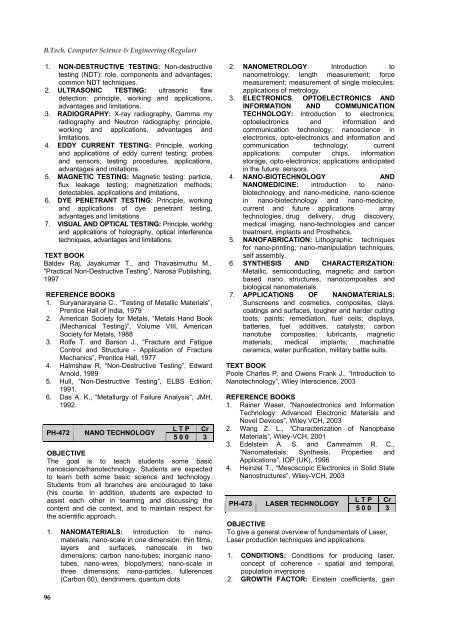B.Tech. Degree Programme Computer Science & Engineering
B.Tech. Degree Programme Computer Science & Engineering
B.Tech. Degree Programme Computer Science & Engineering
Create successful ePaper yourself
Turn your PDF publications into a flip-book with our unique Google optimized e-Paper software.
B.<strong>Tech</strong>. <strong>Computer</strong> <strong>Science</strong> & <strong>Engineering</strong> (Regular)1. NON-DESTRUCTIVE TESTING: Non-destructivetesting (NDT): role, components and advantages;common NDT techniques.2. ULTRASONIC TESTING: ultrasonic flawdetection: principle, working and applications,advantages and limitations.3. RADIOGRAPHY: X-ray radiography, Gamma myradiography and Neutron radiography; principle,working and applications, advantages andlimitations.4. EDDY CURRENT TESTING: Principle, workingand applications of eddy current testing; probesand sensors; testing procedures, applications,advantages and imitations.5. MAGNETIC TESTING: Magnetic testing: particle,flux leakage testing; magnetization methods;detectables. applications and imitations,6. DYE PENETRANT TESTING: Principle, workingand applications of dye penetrant testing,advantages and limitations.7. VISUAL AND OPTICAL TESTING: Principle, workhgand applications of holography, optical interferencetechniques, advantages and limitations.TEXT BOOKBaldev Raj, Jayakumar T., and Thavasimuthu M.,“Practical Non-Destructive Testing”, Narosa Publishing,1997REFERENCE BOOKS1. Suryanarayana C., “Testing of Metallic Materials”,Prentice Hall of India, 19792. American Society for Metals, “Metals Hand Book(Mechanical Testing)”, Volume VIII, AmericanSociety for Metals, 19883. Rolfe T. and Barson J., “Fracture and FatigueControl and Structure - Application of FractureMechanics”, Prentice Hall, 19774. Halmshaw R, “Non-Destructive Testing”, EdwardArnold, 19895. Hull, “Non-Destructive Testing”, ELBS Edition,1991.6. Das A. K., “Metallurgy of Failure Analysis”, JMH,1992.PH-472NANO TECHNOLOGYL T P Cr5 0 0 3OBJECTIVEThe goal is to teach students some basicnanoscience/hanotechnology. Students are expectedto learn both some basic science and technology.Students from all branches are encouraged to take(his course. In addition, students are expected toassist each other in teaming and discussing thecontent and die context, and to maintain respect forthe scientific approach.1. NANOMATERIALS: Introduction to nanomaterials;nano-scale in one dimension: thin films,layers and surfaces, nanoscale in twodimensions: carbon nano-tubes; inorganic nanotubes,nano-wires, biopolymers; nano-scale inthree dimensions: nano-particles, fullerences(Carbon 60), dendrimers, quantum dots2. NANOMETROLOGY: Introduction tonanometrology; length measurement; forcemeasurement; measurement of single molecules;applications of metrology.3. ELECTRONICS, OPTOELECTRONICS ANDINFORMATION AND COMMUNICATIONTECHNOLOGY: Introduction to electronics;optoelectronics and information andcommunication technology; nanoscience inelectronics, opto-electronics and information andcommunication technology; currentapplications: computer chips, informationstorage, opto-electronics; applications anticipatedin the future: sensors.4. NANO-BIOTECHNOLOGY ANDNANOMEDICINE: introduction to nanobiotechnologyand nano-medicine, nano-sciencein nano-biotechnology and nano-medicine,current and future applications arraytechnologies, drug delivery, drug discovery,medical imaging, nano-technologies and cancertreatment, implants and Prosthetics.5. NANOFABRICATION: Lithographic techniquesfor nano-printing; nano-manipulation techniques,self assembly.6. SYNTHESIS AND CHARACTERIZATION:Metallic, semiconducting, magnetic and carbonbased nano structures, nanocomposites andbiological nanomaterials.7. APPLICATIONS OF NANOMATERIALS:Sunscreens and cosmetics, composites, clays.coatings and surfaces, tougher and harder cuttingtoots, paints; remediation, fuel ceils; displays,batteries, fuel additives, catalysts; carbonnanotube composites; lubricants, magneticmaterials; medical implants; machinableceramics, water purification, military battle suits.TEXT BOOKPoole Charles P. and Owens Frank J., “Introduction toNanotechnology”, Wiley lnterscience, 2003REFERENCE BOOKS1. Rainer Waser, “Nanoelectronics and Information<strong>Tech</strong>nology: Advanced Electronic Materials andNovel Devices”, Wiley VCH, 20032. Wang Z. L., “Characterization of NanophaseMaterials”, Wiley-VCH, 20013. Edelstein A. S. and Cammamm R. C.,“Nanomaterials: Synthesis, Properties andApplications”, IOP (UK), 19964. Heinzel T., “Mesoscopic Electronics in Solid StateNanostructures”, Wiley-VCH, 2003PH-473LASER TECHNOLOGYL T P Cr5 0 0 3OBJECTIVETo give a general overview of fundamentals of Laser,Laser production techniques and applications.1. CONDITIONS: Conditions for producing laser,concept of coherence - spatial and temporal,population inversions2. GROWTH FACTOR: Einstein coefficients, gain96
















